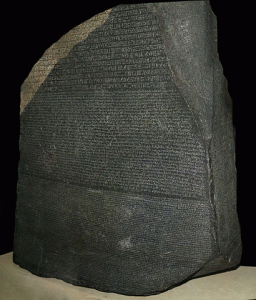Mayan glyphs do NOT have a Rosetta Stone

Rosetta Stone in the British Museum, © Hans Hillewaert / CC-BY-SA-3.0 21 November 2007 licensed under Creative Commons Attribution-Share Alike 3.0 Unported license, retrieved from Wikipedia Commons.
We could have benefited from a Rosetta Stone in deciphering the Mayan glyphs. Even today, after decades of deciphering the ancient glyphs, Maya scholars are still learning how to understand many of the texts. In my humble opinion, the Mayan glyphs are unlike any other writing on earth. No wonder they are so difficult to decipher.
If they had been deciphered earlier, perhaps much of the controversy over the Mayan prophecies for December 21, 2012 would have been clarified sooner.
Unfortunately, the Mayan glyphs do not have a Rosetta Stone as do the Egyptian hieroglyphics. It seemed as if the Egyptian hieroglyphics would never be deciphered until a chance discover by a French soldier in 1799 produced the Rosetta stone. It took 20 years after finding the Rosetta Stone to decipher the hieroglyphics. Without it, Egyptian hieroglyphics may never have been deciphered.
The Rosetta Stone was discovered by a French soldier in 1799 at a time when it seemed as if the Egyptian hieroglyphics would undecipherable. Fortunately, the Rosetta Stone contained the same decree issued on behalf of King Ptolemy V in 196 BC in three languages: Ancient Egyptian hieroglyphs, Demotic script, and Ancient Greek. It provided the key to finally deciphering the Egyptian hieroglyphics.
Originally displayed within a temple, the stele was probably moved during the early Christian or medieval period and eventually used as building material in the construction of Fort Julien near the town of Rashid (Rosetta) in the Nile Delta. It was rediscovered there in 1799 by a soldier,Pierre-François Bouchard, of the French expedition to Egypt.